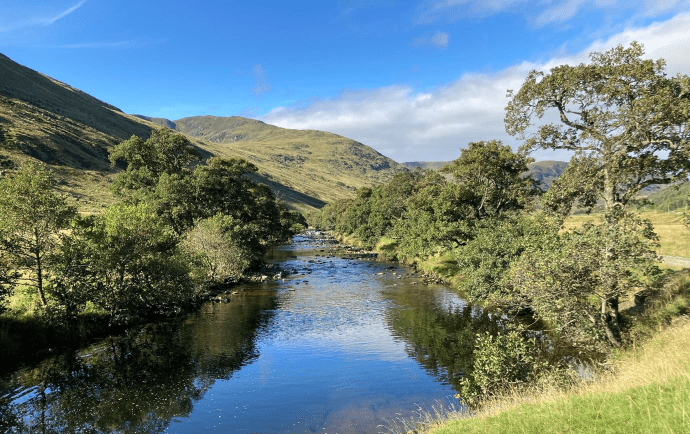Almond Headwaters

Key Facts
- Three neighbouring hill-farming/shooting estates on the River Almond headwaters, in Perthshire, elevations approx 210m – 930m
- The riparian zone across approx 9,000 hectares; potentially wider catchment action.
- 58,000 (55 yrs) - 74,000 (100 yrs) tCO2e for approx 340 hectares new, low-density woodland.
- New Biodiversity Enhancement and agri-env benefit from woodland created.
- Secondary biodiversity and vegetation enhancement from landscape-scale deer management and montane blanket bog recovery. Possible recovery of access to historical salmon redds.
What is the project doing for Nature and Environment?
- Riparian woodland recovery along main watercourse and some tributaries; pasture-woodland recovery in blocks in the glen; small areas of montane scrub recovery; possible salmon redds (the nests that trout and salmon build in the bottom of the river to lay their eggs in).
- Fencing, planting and browsing control (livestock and wild deer); secondary activities possible with deer-management generally across the landscape, thus also facilitating peatland recovery activity on extensive areas of montane blanket bog. Potential new fish-ladder works.
- CreditNature NARIA framework assessment; TrinityAg’s ‘Sandy’ carbon audit dashboard for land management.
How are communities engaged and benefiting?
- Structured contact is being delivered for the hyper-local community of estate staff and tenants, eventually expanding to organisations in the distant towns and villages.
- Socio-environmental impacts from a relatively minor landscape change are more likely to be job retention/environmental integrity impacts, rather than creation of jobs or of asset/benefit sharing.
- Proof of concept results will determine if the changes can be scaled and rolled out for greater impact.
What is the business model employed to fund the project?
- The project is delivered with grant from Esmee Fairbairn Foundation to Perth and Kinross Countryside Trust, in a ‘proof of concept’ business model.
- The outputs will be learnings about supporting nature recovery on private land with third party private + public funds, and how much community agency is possible within such transactions.
- Financial and non-financial dividends will be explored. The grant allows preliminary investigative action at zero cash-cost to all project participants.
Describe the partnerships formed and how they support project viability?
- Three neighbouring upland estates requested to participate as suppliers, as did two major utility companies and a local distillery as buyers. ‘Community’ was then identified around the geography of the landowners.
- Contracting between suppliers, buyers and community is the subject of the project investigation; we have MoUs from suppliers and buyers to participate in this.
- We believe we can grow the relationships that we have built with stakeholders.
What are the main challenges and risks to the project and how are they managed?
- Disentangling interdependent ecosystem components into discrete commodities that can appear (through MRV) in organisations’ finances, especially their assets/liabilities. This impacts the concept’s credibility in all three stakeholder groups. We need to show how ESG/CSR RoI will drive more credibility than financial RoI.
- Non financial perspectives – estates are culturally deeply invested in hill farming and shooting, often supported by policy.
Key Learning and Insights
Many investment readiness development projects are seeking the same learning about proving nature finance concepts; but our context is for a very specific geography, a very specific type of land manager, and a very sparse local community.
Website: https://www.pkct.org/pages/category/riverwoods-almond-headwaters
Contact David.Tollick@pkct.org
